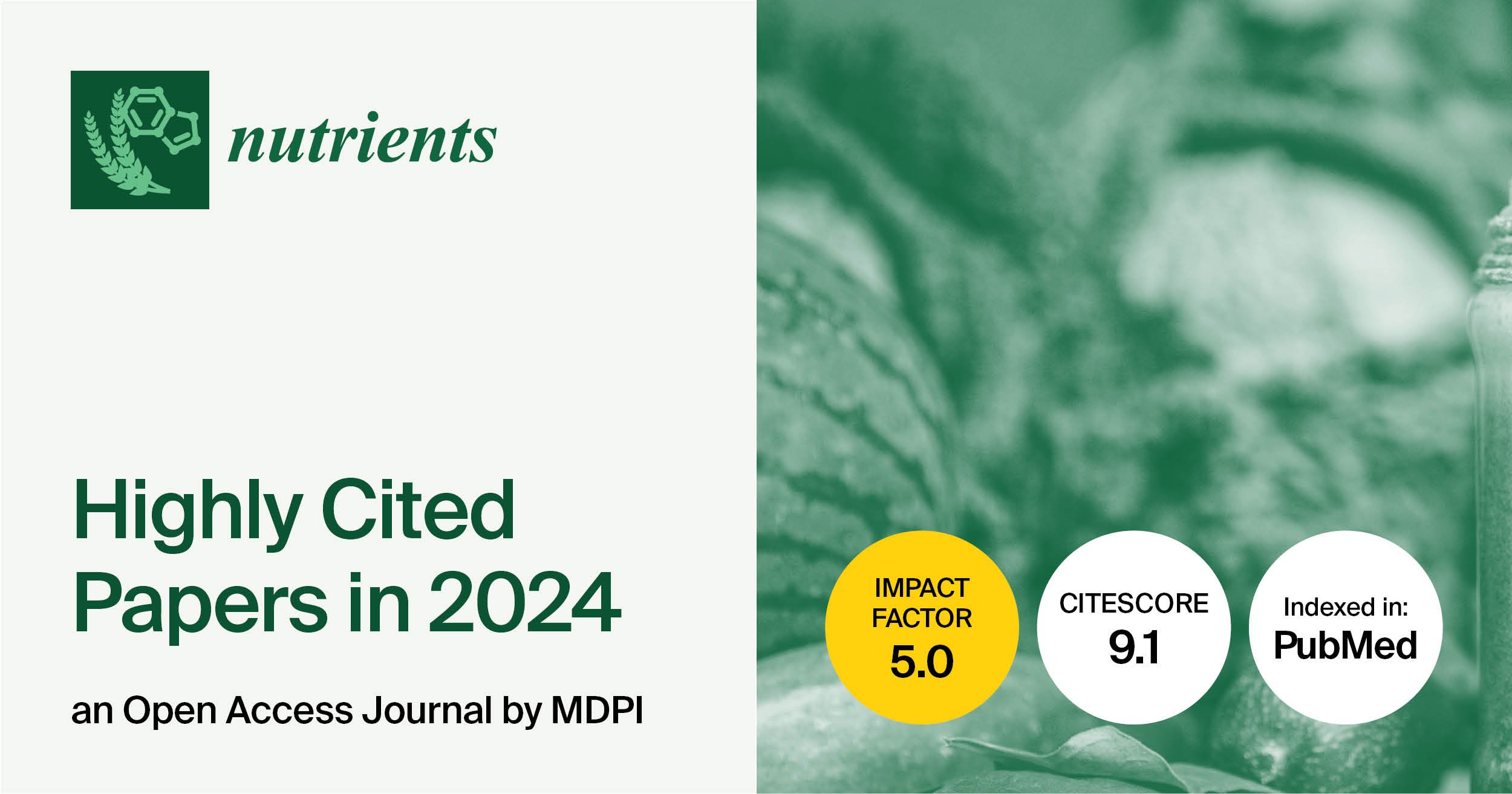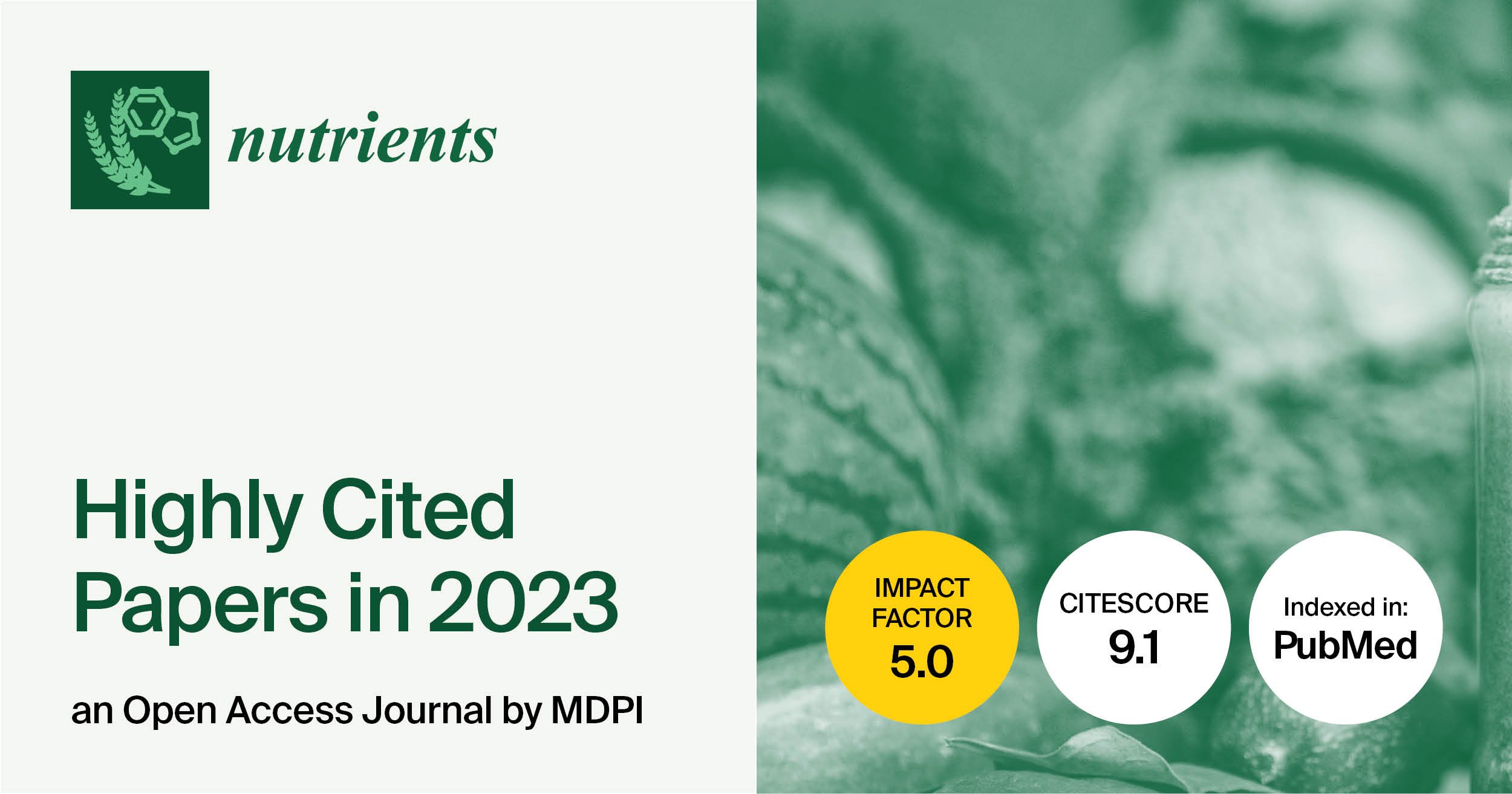Journal Description
Nutrients
Nutrients
is an international, peer-reviewed, open access journal of human nutrition published semimonthly online by MDPI. The Asia Pacific Nutrigenomics Nutrigenetics Organisation (APNNO), Italian Society for Pediatric Gastroenterology, Hepatology and Nutrition (SIGENP), Nutrition Society of New Zealand (NSNZ), Ocular Wellness & Nutrition Society (OWNS) and others are affiliated with Nutrients and their members receive a discount on article processing charges.
- Open Access— free for readers, with article processing charges (APC) paid by authors or their institutions.
- High Visibility: indexed within Scopus, SCIE (Web of Science), PubMed, MEDLINE, PMC, Embase, PubAg, AGRIS, and other databases.
- Journal Rank: JCR - Q1 (Nutrition and Dietetics) / CiteScore - Q1 (Nutrition and Dietetics)
- Rapid Publication: manuscripts are peer-reviewed and a first decision is provided to authors approximately 12.9 days after submission; acceptance to publication is undertaken in 2.3 days (median values for papers published in this journal in the first half of 2025).
- Recognition of Reviewers: reviewers who provide timely, thorough peer-review reports receive vouchers entitling them to a discount on the APC of their next publication in any MDPI journal, in appreciation of the work done.
- Companion journal: Dietetics.
- Journal Cluster of Food, Nutrition, and Health Science: Beverages, Dietetics, Foods, Nutraceuticals, Nutrients and Obesities.
Impact Factor:
5.0 (2024);
5-Year Impact Factor:
6.0 (2024)
Latest Articles
Changes in Difficulties in Emotion Regulation Following Eating Disorders Treatment: Relevant Prospective Implications for Treatment Outcome
Nutrients 2025, 17(21), 3470; https://doi.org/10.3390/nu17213470 - 3 Nov 2025
Abstract
Background: Difficulties in emotion regulation (ER) are commonly described in eating disorders (ED), but few studies report its impact on ED treatment outcome. The main goal of this study was to investigate the patterns of change in difficulties in ER among ED-diagnosed
[...] Read more.
Background: Difficulties in emotion regulation (ER) are commonly described in eating disorders (ED), but few studies report its impact on ED treatment outcome. The main goal of this study was to investigate the patterns of change in difficulties in ER among ED-diagnosed female patients who received a Cognitive Behavioral Therapy (CBT) treatment. Methods: Participants (N = 74; Mage = 29.2; SD = 11.5) completed pre- and post-treatment questionnaires to assess difficulties in ER, disordered eating symptoms, general psychopathology, and personality traits. Results: Considering ED treatment outcome status, 24.3% of patients displayed a poor outcome, while 28.4% achieved partial remission, and 47.3% achieved full remission. Most of the patients who achieved full remission (80%) reported decreases in difficulties in ER, while only 55.6% of the participants displaying poor outcomes reported improvements in ER. The results from the structural equation modeling (SEM) suggest that the risk of poor outcome was directly related to increased post-treatment difficulties in ER, while improvements in the severity index of global psychopathology was related to increased pre-treatment difficulties in ER. Conclusions: Better ED treatment outcomes are associated with higher levels of ER improvements. Future prospective studies are warranted to establish which ER components may positively influence the recovery of ED-diagnosed patients.
Full article
(This article belongs to the Special Issue Integration of Nutritional and Psychological Interventions in the Management of Anorexia Nervosa, Bulimia Nervosa and Other Eating Disorders)
Open AccessReview
Impact of Diverse Dietary Patterns on Cognitive Health: Cumulative Evidence from Prospective Cohort Studies
by
Youngyo Kim, Minkyung Je, Kyeonghoon Kang and Yoona Kim
Nutrients 2025, 17(21), 3469; https://doi.org/10.3390/nu17213469 - 3 Nov 2025
Abstract
Background/Objectives: The aging population is associated with an increased incidence of dementia, which deteriorates the quality of life of adults, leading to an elevated socioeconomic burden. This review aimed to extensively examine which dietary patterns favorably influence cognitive outcomes based on prospective cohort
[...] Read more.
Background/Objectives: The aging population is associated with an increased incidence of dementia, which deteriorates the quality of life of adults, leading to an elevated socioeconomic burden. This review aimed to extensively examine which dietary patterns favorably influence cognitive outcomes based on prospective cohort studies of adults. Methods: A literature search was performed in the PubMed®/MEDLINE® database up to 30 October 2024. Results: One hundred and eighteen publications were included. In a comparison of high and low categories, the Mediterranean-Dietary Approaches to Stop Hypertension Intervention for Neurodegenerative Delay (MIND) diet increased cognitive function and reduced the risk of cognitive impairment. The Mediterranean (MED) diet improved cognitive function but showed no beneficial effects on cognitive impairment or dementia. The Dietary Approaches to Stop Hypertension (DASH) diet lowered the risk of cognitive impairment but showed no alteration in either cognitive function or dementia. The Healthy Eating Index (HEI) did not alter cognitive function, cognitive impairment, or dementia. The healthy plant-based dietary index (hPDI) decreased the risk of cognitive impairment and dementia, whereas the unhealthy plant-based dietary index (uPDI) elevated the risk of cognitive impairment. The Western dietary pattern (WDP) decreased cognitive function. Conclusions: The MIND diet and hPDI appeared to be effective, while the WDP appeared to be detrimental for cognitive health. Further prospective cohort studies of healthy and unhealthy dietary patterns are required to confirm the association between diverse diets and cognitive health.
Full article
(This article belongs to the Special Issue Impact of Dietary Patterns, Nutrition, and Lifestyle on Aging and Elderly Health)
Open AccessReview
Peptide YY in Type 2 Diabetes: A Complementary Gut Hormone with Therapeutic Potential Beyond GLP-1
by
Nhi Thi Nguyen and Jae-Hyung Park
Nutrients 2025, 17(21), 3468; https://doi.org/10.3390/nu17213468 - 3 Nov 2025
Abstract
Type 2 diabetes (T2D) is a complex metabolic disease characterized by insulin resistance, progressive β-cell dysfunction, and persistent hyperglycemia. While GLP-1 receptor agonists have revolutionized the management of T2D by improving glycemic control and reducing body weight, their insulinotropic effects increase the workload
[...] Read more.
Type 2 diabetes (T2D) is a complex metabolic disease characterized by insulin resistance, progressive β-cell dysfunction, and persistent hyperglycemia. While GLP-1 receptor agonists have revolutionized the management of T2D by improving glycemic control and reducing body weight, their insulinotropic effects increase the workload on pancreatic β-cells, which may hasten β-cell decline in certain individuals. Peptide YY (PYY), a gut-derived hormone secreted alongside glucagon-like peptide-1 (GLP-1) from L-cells, presents a unique and complementary therapeutic approach. In contrast to GLP-1, PYY does not directly induce insulin release but confers metabolic advantages by suppressing appetite through Y2 receptor pathways, enhancing insulin sensitivity via peripheral Y1/Y4 receptors, and slowing gastric emptying to minimize postprandial glucose surges. Notably, recent research suggests PYY supports the preservation and restoration of pancreatic islets by improving their structure and function without increasing the secretory demand. PYY levels are substantially increased after bariatric surgery, where it plays a pivotal role in weight-loss-independent improvements in glycemic regulation and islet hormone dynamics. These attributes position PYY as a strong candidate for use in combination with GLP-1 analogs, especially in individuals with advanced β-cell impairment or those who respond inadequately to GLP-1 monotherapy. This review discusses PYY’s physiological functions, mechanistic actions, and therapeutic opportunities in T2D, highlighting its potential as a valuable adjunct or alternative in gut-hormone-oriented treatment strategies.
Full article
(This article belongs to the Collection Bioactive Peptides: Challenges and Opportunities)
Open AccessArticle
Association Between Dietary Tomato Intake and Blood Eosinophil Count in Middle-Aged and Older Japanese Individuals: A Population-Based Cross-Sectional Study †
by
Akinori Hara, Hiromasa Tsujiguchi, Rio Fukuchi, Masaharu Nakamura, Jam Camara, Marama Talica, Jiaye Zhao, Chie Takazawa, Fumihiko Suzuki, Haruhiko Ogawa, Takayuki Kannon, Takehiro Sato, Atsushi Tajima and Hiroyuki Nakamura
Nutrients 2025, 17(21), 3467; https://doi.org/10.3390/nu17213467 - 3 Nov 2025
Abstract
Background/Objectives: Although tomato consumption has been associated with positive health outcomes, it remains unclear whether it can prevent or exacerbate allergic diseases by regulating eosinophils. We explored the association between dietary tomato intake and blood eosinophil counts in Japanese individuals. Methods:
[...] Read more.
Background/Objectives: Although tomato consumption has been associated with positive health outcomes, it remains unclear whether it can prevent or exacerbate allergic diseases by regulating eosinophils. We explored the association between dietary tomato intake and blood eosinophil counts in Japanese individuals. Methods: This population-based, cross-sectional study included 1013 participants aged ≥ 40 years. The dietary intake of tomatoes was assessed using a validated, self-administered diet history questionnaire. The peripheral blood eosinophil count was measured, and an elevated blood eosinophil count was defined as a value that exceeded the ≥75th percentile. Results: The mean age of the participants was 62.5 ± 11.2 years, with 474 (46.8%) being male. Overall, 252 participants exhibited elevated blood eosinophil counts (≥204/μL). In the multivariable logistic regression model with adjustment for potential confounders, an increase in tomato intake of 10 g was inversely associated with an elevated blood eosinophil count (odds ratio [OR], 0.895; 95% confidence interval [CI], 0.834–0.961). Except for chronic kidney disease, the baseline participant characteristics did not influence this association. Conclusions: Low dietary tomato intake was associated with an elevated blood eosinophil count in middle-aged and older Japanese individuals. These results may provide insight into the dietary management of eosinophil-related allergic and type 2 inflammatory diseases.
Full article
(This article belongs to the Special Issue Antioxidant-Rich Natural Fruit and Vegetable Foods and Human Health)
►▼
Show Figures

Figure 1
Open AccessArticle
Synthetic Food Preservatives Modulate Apoptotic Gene Expression in HepG2 Cells: Divergent Effects of Sodium Benzoate, Potassium Sorbate, and Sodium Metabisulfite
by
Márton Pintér, John M. Macharia, Orsolya Liza Kövesdi, Nóra Rozmann, Afshin Zand, Katalin Szerb, Tímea Varjas and Bence László Raposa
Nutrients 2025, 17(21), 3466; https://doi.org/10.3390/nu17213466 - 3 Nov 2025
Abstract
Background: The accelerated lifestyle of modern society has increased reliance on processed foods preserved with synthetic additives. Although these substances effectively extend shelf life, several studies have raised concerns about potential adverse effects, suggesting that excessive or long-term exposure may interfere with essential
[...] Read more.
Background: The accelerated lifestyle of modern society has increased reliance on processed foods preserved with synthetic additives. Although these substances effectively extend shelf life, several studies have raised concerns about potential adverse effects, suggesting that excessive or long-term exposure may interfere with essential cellular processes, including apoptosis. Objectives: This study aimed to investigate the impact of three widely used synthetic food preservatives; sodium benzoate (SB), potassium sorbate (PS), and sodium metabisulfite (SMB) on apoptosis-related gene expression in the human hepatocellular carcinoma cell line (HepG2). Methods: HepG2 cells were exposed to five increasing concentrations (6.25, 12.5, 25, 50, and 100 mg/L) of SB, PS, or SMB for 24 and 48 h. The transcriptional changes of key apoptotic genes (CASP3, CASP8, BAX, and BCL2) were quantified by real-time quantitative reverse transcription PCR (RT-qPCR) to evaluate their potential effects on intrinsic and extrinsic apoptotic pathways. Results: SB and PS induced dose-dependent transcriptional changes in apoptosis-related genes. Both preservatives upregulated BAX and downregulated BCL2, indicating an intrinsic pathway response, while simultaneously decreasing CASP3 and CASP8 expression associated with the extrinsic pathway. In contrast, SMB did not cause significant gene expression changes. Conclusions: SB and PS induced concentration- and time-dependent transcriptional alterations in apoptosis-related genes in HepG2 cells. In contrast, SMB did not elicit significant gene expression changes under the same conditions. These gene-level modulations were most evident at higher concentrations, which exceed typical dietary exposure levels. Therefore, while SB and PS were associated with transcriptional alterations at higher, experimentally relevant concentrations, additional research using primary human hepatocytes is needed to determine whether similar patterns occur in normal liver cells under physiological exposure conditions.
Full article
(This article belongs to the Special Issue Dietary Effects on Gene Expression and Metabolic Profiles)
Open AccessBrief Report
High Consumption of Ultra-Processed Foods Is Associated with Genome-Wide DNA Methylation Differences in Women: A Pilot Study
by
Alessandra Escorcio Rodrigues, Ariana Ester Fernandes, Alexis Germán Murillo Carrasco, Felipe Mateus Pellenz, Paula Waki Lopes da Rosa, Aline Maria da Silva Hourneaux de Moura, Fernanda Galvão de Oliveira Santin, Cintia Cercato, Maria Edna de Melo and Marcio C. Mancini
Nutrients 2025, 17(21), 3465; https://doi.org/10.3390/nu17213465 - 3 Nov 2025
Abstract
Background/Objectives: The global increase in the consumption of ultra-processed foods (UPFs) parallels the rise in obesity and non-communicable chronic diseases. Although several large-scale studies associate UPF intake with adverse health outcomes, the biological mechanisms remain unclear. Epigenetic alterations, such as changes in DNA
[...] Read more.
Background/Objectives: The global increase in the consumption of ultra-processed foods (UPFs) parallels the rise in obesity and non-communicable chronic diseases. Although several large-scale studies associate UPF intake with adverse health outcomes, the biological mechanisms remain unclear. Epigenetic alterations, such as changes in DNA methylation, may represent a potential pathway by which diet influences metabolic health. The aim of this study was to investigate whether higher UPF consumption is associated with genome-wide DNA methylation patterns in women. Methods: This was a cross-sectional observational study with exploratory epigenetic analysis. We selected 30 women, who were divided into tertiles based on their UPF consumption (expressed as a percentage of total energy intake) according to the NOVA food classification system. Dietary intake was assessed using a three-day food record. Anthropometric data, body composition and laboratory parameters were evaluated. The analysis of DNA methylation was performed utilizing DNA extracted from peripheral blood leukocytes of participants in the first and third tertiles of UPF consumption. Genome-wide methylation patterns were performed using next-generation sequencing. Results: Participants had a median (IQR) age of 31 years (26.0–36.5) and a BMI of 24.7 (23.6–35.8) kg/m2. For the epigenetic analyses, 15 women were included. Of the 30 women initially evaluated, 20 were included as they belonged to the first and third tertile of UPF consumption. Of these, five were excluded due to a low number of reads obtained by NGS. A total of 80 differentially methylated regions were identified between groups, most of which were hypomethylated in the high-UPF-intake group. Conclusions: High UPF consumption was associated with altered DNA methylation patterns, suggesting a potential epigenetic mechanism underlying the negative health effects of UPFs. This pilot study provides a model for future research with larger samples.
Full article
(This article belongs to the Special Issue The Impact of Dietary Trends on Physiological Processes in Human Health)
►▼
Show Figures
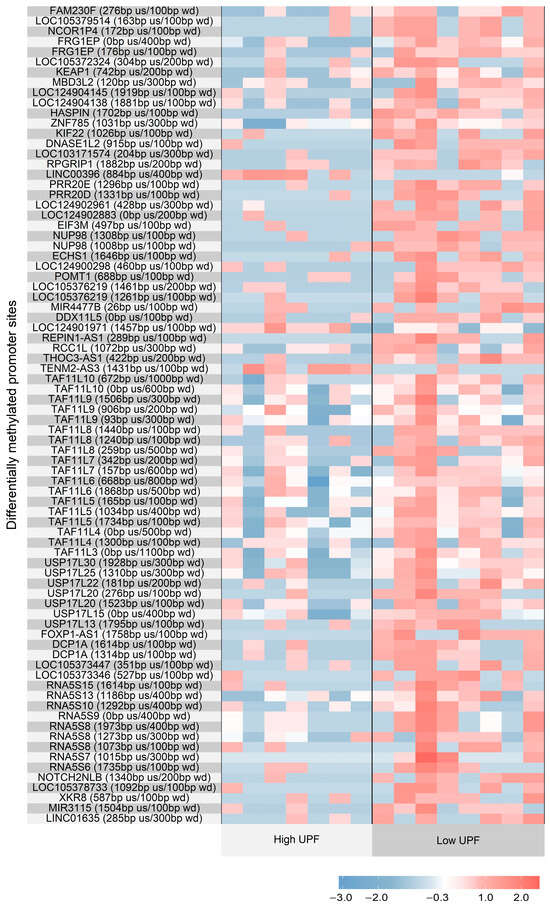
Figure 1
Open AccessReview
High Salt Intake and Atherosclerosis Progression—Not Only via Blood Pressure: A Narrative Review
by
Stanisław Surma, Bogusław Okopień, Andrew J. Murphy and Maciej Banach
Nutrients 2025, 17(21), 3464; https://doi.org/10.3390/nu17213464 - 3 Nov 2025
Abstract
Excessive dietary salt intake remains a critical and underestimated global health concern, strongly associated with increased cardiovascular disease risk. While the relationship between salt and arterial hypertension is well established, accumulating evidence highlights additional, blood pressure-independent mechanisms linking high salt intake with the
[...] Read more.
Excessive dietary salt intake remains a critical and underestimated global health concern, strongly associated with increased cardiovascular disease risk. While the relationship between salt and arterial hypertension is well established, accumulating evidence highlights additional, blood pressure-independent mechanisms linking high salt intake with the progression of atherosclerosis. Beyond its hypertensive effects, high dietary salt directly damages the vascular endothelium by disrupting the glycocalyx, reducing nitric oxide synthesis, and increasing endothelial stiffness and inflammation. Excess sodium also impairs glycosaminoglycan buffering capacity and promotes immune cell adhesion, even in normotensive individuals. Furthermore, salt-induced dysbiosis of the gut microbiota alters the metabolic and inflammatory environment, lowering beneficial short-chain fatty acids and increasing pro-atherogenic metabolites such as trimethylamine N-oxide. Recent findings also implicate salt-driven modulation of hematopoiesis via Th17 cytokines, which enhances the production of pro-inflammatory monocytes that accelerate plaque development. These findings support the notion that high salt intake may be an independent and modifiable residual risk factor for atherosclerotic cardiovascular disease. Reducing dietary sodium—particularly from processed foods—should therefore remain a central component of both primary and secondary cardiovascular prevention. Although the optimal range of salt intake remains under discussion, a moderate reduction to below 5 g/day is considered safe and beneficial.
Full article
(This article belongs to the Special Issue Nutritional Aspects of Cardiovascular Disease Risk Factors)
►▼
Show Figures

Figure 1
Open AccessArticle
A Proanthocyanidins-Rich Cili (Rosa roxburghii) Fruit Extract Protects CCl4-Induced Mouse Hepatic Fibrosis via Modulation of Ferroptosis and Gut Microbiota
by
Yang Liu, Jingzhong Zheng, Xin Zheng, Dan Zhou, Hang Ma, Xue Zhou and Fahuan Ge
Nutrients 2025, 17(21), 3463; https://doi.org/10.3390/nu17213463 - 3 Nov 2025
Abstract
Background: Cili (Rosa roxburghii Tratt) is a unique fruit native to China’s Yunnan–Guizhou Plateau, rich in vitamin C, polyphenols, and triterpene, with broad health-promoting effects. Although cili’s hepatoprotective properties are reported, the bioactive components and underlying mechanisms remain poorly defined. Methods: We
[...] Read more.
Background: Cili (Rosa roxburghii Tratt) is a unique fruit native to China’s Yunnan–Guizhou Plateau, rich in vitamin C, polyphenols, and triterpene, with broad health-promoting effects. Although cili’s hepatoprotective properties are reported, the bioactive components and underlying mechanisms remain poorly defined. Methods: We enriched proanthocyanidins from cili using column chromatography, identified their components via UPLC-Q-TOF-MS/MS, and validated their anti-liver fibrosis effects through in vitro and in vivo experiments. Results: Herein, we developed a novel proanthocyanidin-rich cili fruit extract (PACs-CFE) containing 84.2% total proanthocyanidins, comprising catechins, epicatechins, and diverse B-type dimers, trimers, tetramers, and gallate esters, as characterized by UPLC-Q-TOF-MS/MS. PACs-CFE inhibited LX-2 activation, suppressed collagen III and α-SMA expression, and induced ferroptosis via mitochondrial injury, reactive oxygen species accumulation, and GPX4/ferritin downregulation. In vivo, PACs-CFE ameliorated liver fibrosis, restored hepatic architecture, and improved serum alanine aminotransferase, aspartate aminotransferase, and bilirubin profiles. Moreover, PACs-CFE modulated the TGF-β1/Smad3 signaling pathway and beneficially reshaped the gut microbiota, enriching anti-inflammatory and hepatoprotective genera while reducing pathogenic taxa. Conclusions: Our findings show that PACs-CFE exerts multi-targeted anti-fibrotic effects through hepatic stellate cell inactivation, ferroptosis induction, TGF-β1/Smad3 suppression, and gut–liver axis modulation. This study provides useful insight into the hepatoprotective potential of cili fruit and supports its development as standardized functional ingredients for liver health.
Full article
(This article belongs to the Special Issue The Role of Health Benefits of Plant Extracts in Reduction of Rescue Medication)
►▼
Show Figures

Figure 1
Open AccessArticle
Rosa canina Extract Attenuates Muscle Atrophy in L6 Myotubes and Immobilized Mice
by
Hyerin Lee, Mi-Bo Kim, Junhui Kang, Jae-Kwan Hwang and Bohkyung Kim
Nutrients 2025, 17(21), 3462; https://doi.org/10.3390/nu17213462 - 2 Nov 2025
Abstract
Background: Skeletal muscle is essential not only for structural integrity but also metabolic homeostasis. Muscle atrophy, the loss of muscle mass and function, is closely linked to chronic and metabolic disorders and is driven by chronic inflammation, oxidative stress, impaired myogenesis, and
[...] Read more.
Background: Skeletal muscle is essential not only for structural integrity but also metabolic homeostasis. Muscle atrophy, the loss of muscle mass and function, is closely linked to chronic and metabolic disorders and is driven by chronic inflammation, oxidative stress, impaired myogenesis, and disrupted protein homeostasis. The present study aimed to evaluate the protective effects and underlying mechanisms of Rosa canina extract (RCE), a polyphenol-rich plant known for its antioxidant and anti-inflammatory properties, in vitro and in vivo models of muscle atrophy. Methods: We investigated the effects of RCE in TNF-α-treated L6 myotubes and a mouse model (eight-week-old male C57BL/6N) of immobilization-induced muscle atrophy. Markers of inflammation, oxidative stress, myogenesis, protein turnover, and anabolic signaling were analyzed via RT-PCR, Western blotting and ELISA. Muscle mass, performance, micro-CT imaging, and histological cross-sectional area were assessed in vivo. Results: RCE suppressed pro-inflammatory cytokines, restored antioxidant enzyme expression, and preserved myogenic markers. It inhibited muscle proteolysis by downregulating the genes involved in protein degradation and promoted protein synthesis by via activation of the PI3K/Akt/mTOR pathway. In mice, RCE mitigated muscle mass loss, preserved fiber cross-sectional area, improved strength and endurance, and restored muscle volume. Conclusions: RCE attenuated muscle atrophy by targeting inflammation, oxidative stress, proteolysis, and impaired anabolism. These findings highlight RCE as a promising natural therapeutic for preserving muscle health and metabolic homeostasis.
Full article
(This article belongs to the Special Issue Prevention Effects and Molecular Mechanisms of Dietary Bioactive Compounds Against Chronic Diseases)
►▼
Show Figures

Figure 1
Open AccessArticle
Estimated Amounts of β-Carotene, Vitamin B6, Riboflavin and Niacin in the Daily Diet of Older Subjects Associate Negatively with ADP-Induced Aggregation of Blood Platelets Independently of Cardiovascular Risk Factors
by
Kamil Karolczak, Agnieszka Guligowska, Bartłomiej K. Sołtysik, Joanna Kostanek, Tomasz Kostka and Cezary Watala
Nutrients 2025, 17(21), 3461; https://doi.org/10.3390/nu17213461 - 2 Nov 2025
Abstract
Background/Objectives: Platelet-dependent thrombotic risk increases with age. Little is known, however, about the potential effect of vitamins on platelet reactivity in older subjects. Methods: Therefore, in the present study we examined the dependencies of whole blood platelet aggregability (in response to arachidonic acid
[...] Read more.
Background/Objectives: Platelet-dependent thrombotic risk increases with age. Little is known, however, about the potential effect of vitamins on platelet reactivity in older subjects. Methods: Therefore, in the present study we examined the dependencies of whole blood platelet aggregability (in response to arachidonic acid (AA), collagen (COL) or adenosinediphosphate (ADP), using impedance aggregometry) in older men and women (60–65 yr, n = 246) on the intakes of vitamins (vitamins A, E, C, B6, B12 and D, niacin, thiamine, riboflavin, retinol, β-carotene and folates) with a typical daily diet (vitamin contents estimated using Dieta 5.0 software). Results: Overall, significant negative bootstrap-boosted partial correlation coefficients, adjusted for selected cardiovascular risk factors, were revealed for AA and β-carotene, and ADP and β-carotene, riboflavin, vitamin B6 and niacin. These findings were further validated by the outcomes of the bootstrap-boosted canonical analysis, confirming the relationships revealed for ADP, and to a lesser extent for AA. COL-dependent platelet aggregation appeared to not be associated with the amount of vitamins in the subjects’ daily diet. Conclusions: Hence, we conclude that the intake of vitamins in the daily diet of older subjects is negatively associated with platelet aggregability in an agonist- and vitamin-specific manner.
Full article
(This article belongs to the Section Geriatric Nutrition)
Open AccessArticle
Sex Differences in Associations Between Diet and Metabolic Health in Older Adults: The Roles of Vegetable Protein and Alcohol Intake
by
Kayla R. Anderson, Philip A. Kern, Allison L. Steele, Brooke D. Lancaster, Madison Bee, Alyaa M. Zagzoog, Stacey A. Slone, Douglas E. Long and Jean L. Fry
Nutrients 2025, 17(21), 3460; https://doi.org/10.3390/nu17213460 - 2 Nov 2025
Abstract
Background/Objective: Aging is associated with a decline in metabolic health, including impaired glucose regulation. Both diet and biological sex impact metabolic health, yet sexual heterogeneity in diet response is understudied. We report on exploratory analyses of sex-specific associations between diet and insulin sensitivity,
[...] Read more.
Background/Objective: Aging is associated with a decline in metabolic health, including impaired glucose regulation. Both diet and biological sex impact metabolic health, yet sexual heterogeneity in diet response is understudied. We report on exploratory analyses of sex-specific associations between diet and insulin sensitivity, insulin resistance, and android and intermuscular fat composition in older adults. Methods: This secondary analysis uses baseline data from a previously completed clinical trial (n = 96), the MASTERS study. An oral glucose tolerance test (OGTT) was used to calculate insulin resistance and insulin sensitivity as measures of metabolic function, while dual-energy x-ray absorptiometry and computed tomography were used to assess body composition. Univariate analyses were used to identify sex-specific associations between metabolic health and single nutrients, as well as other dietary components. Feasible solutions algorithm (FSA) modeling was employed to identify food groups that were most associated with insulin sensitivity. Results: In men, greater intakes of vegetable protein (p < 0.0001) and whole grains (p = 0.001) were associated with higher insulin sensitivity, while refined grains (p = 0.003) and conjugated linoleic acids (p < 0.001) were negatively associated. In women, insulin sensitivity was positively associated with alcohol (p < 0.001) and xylitol (p = 0.007). FSA modeling identified whole grains, nuts, and seeds as food groups that predicted higher insulin sensitivity in men, while alcohol remained the strongest predictor in women. Conclusions: Men showed higher insulin sensitivity with plant-based diets, while alcohol intake was the dietary factor most associated with insulin sensitivity in women. The findings of these exploratory analyses support the need for sex-specific clinical trials and dietary guidance for aging populations.
Full article
(This article belongs to the Special Issue Association between Nutrition, Diet Quality, Dietary Patterns, and Human Health and Diseases—2nd Edition)
►▼
Show Figures

Figure 1
Open AccessArticle
Effects of High-Protein Nutritional Guidance on Sarcopenia-Related Parameters in Individuals Aged ≥ 75 Years with Type 2 Diabetes: An Exploratory Single-Arm Pre–Post Intervention Study
by
Hidechika Todoroki, Takeshi Takayanagi, Risa Morikawa, Yohei Asada, Shihomi Hidaka, Yasumasa Yoshino, Izumi Hiratsuka, Megumi Shibata, Ayumi Wada, Shiho Asai, Akemi Ito, Kosei Kamimura, Yuuka Fujiwara, Hitoshi Kuwata, Yoshiyuki Hamamoto, Yusuke Seino and Atsushi Suzuki
Nutrients 2025, 17(21), 3459; https://doi.org/10.3390/nu17213459 - 1 Nov 2025
Abstract
Background: Sarcopenia and metabolic deterioration are major health concerns in adults aged ≥ 75 years with type 2 diabetes (T2DM), a population characterized by anabolic resistance, reduced dietary intake, and limited renal reserve. Optimizing protein nutrition may support muscle maintenance in this high-risk
[...] Read more.
Background: Sarcopenia and metabolic deterioration are major health concerns in adults aged ≥ 75 years with type 2 diabetes (T2DM), a population characterized by anabolic resistance, reduced dietary intake, and limited renal reserve. Optimizing protein nutrition may support muscle maintenance in this high-risk group, but clinical evidence for individualized high-protein guidance in the oldest-old population remains limited. Objective: We investigated whether an 18-month dietary intervention improves muscle mass and strength in adults aged ≥ 75 years with T2DM and whether serum amino acid (AA) and hormonal profiles reflect these changes. Methods: In this 18-month, single-arm, prospective intervention study, 44 community-dwelling adults aged ≥ 75 years with T2DM received individualized, dietitian-led nutritional guidance targeting a protein intake of approximately 1.4 g/kg ideal body weight (IBW)/day. Assessments at baseline and every 6 months included body composition, muscle strength, renal function, and fasting serum amino acid and hormonal profiles. Longitudinal changes were analyzed using paired t-tests and linear mixed-effects models. This trial was registered in the UMIN Clinical Trials Registry (UMIN000044687). Results: Skeletal muscle index and grip strength showed significant improvements at specific time points during follow-up (both p < 0.05), while gait speed improved at 6 months. Renal function remained clinically stable (eGFRcreat slope: +0.18 mL/min/1.73 m2/year; eGFRcys slope: −2.97 mL/min/1.73 m2/year), with no significant increase in CKD stage. Changes in glucagon correlated positively and C-peptide negatively with changes in skeletal muscle index, whereas glucagon was inversely associated with grip strength. Serum fibroblast growth factor 21 (FGF21) levels decreased over time, suggesting metabolic adaptation to the intervention. Conclusions: Individualized high-protein nutritional guidance for 18 months improved sarcopenia-related parameters, including skeletal muscle index and grip strength, without clinically significant deterioration of renal function in adults aged ≥ 75 years with T2DM. These findings support the feasibility and safety of protein-focused dietary counseling as a strategy to preserve muscle health in advanced age.
Full article
(This article belongs to the Section Nutrition and Diabetes)
►▼
Show Figures

Graphical abstract
Open AccessArticle
Potential Effects of Nicotinamide on Serum HDL-Cholesterol Levels and Hepatic Oxidative Stress, ABCA1 Gene and Protein Expression in Rats Fed a High-Fat/Fructose Diet
by
Jesús I. Serafín-Fabián, Armando Ramírez-Cruz, J. D. Villeda-González, Jaime Gómez-Zamudio, Adrián Hernández-Díazcouder, Clara Ortega-Camarillo, Eugenia Flores-Alfaro, Miguel Cruz and Miguel Vazquez-Moreno
Nutrients 2025, 17(21), 3458; https://doi.org/10.3390/nu17213458 - 1 Nov 2025
Abstract
A hypercaloric diet is associated with oxidative stress and the dysfunction of ATP-Binding Cassette transporter A1 (ABCA1), a key element in high-density lipoprotein (HDL) biogenesis and reverse cholesterol transport. Nicotinamide (NAM) presents antioxidant properties, which may contribute to maintaining lipid metabolism. Therefore, we
[...] Read more.
A hypercaloric diet is associated with oxidative stress and the dysfunction of ATP-Binding Cassette transporter A1 (ABCA1), a key element in high-density lipoprotein (HDL) biogenesis and reverse cholesterol transport. Nicotinamide (NAM) presents antioxidant properties, which may contribute to maintaining lipid metabolism. Therefore, we aimed to evaluate the effect of NAM on HDL-cholesterol (HDL-C) level, oxidative stress markers, and the gene expression and protein levels of ABCA1 in Sprague-Dawley rats fed a hypercaloric diet. Forty male rats were divided into five groups: one group received a standard diet, and the remaining groups received a single high-fat, high-fructose diet (HFDF). Three of the HFDF groups received NAM treatment (5, 10, and 15 mM) in drinking water for 16 weeks (5 h/day). While HDL-C and oxidative stress were measured in serum samples, oxidative stress markers, and the gene expression and protein levels of ABCA1 were quantified in liver samples. The HDL-C level altered by the HFDF was improved by treatment with NAM. Furthermore, NAM reduces systemic lipid peroxidation levels and enhances the hepatic antioxidant response affected by the HFDF. In addition, NAM modulates the hepatic ABCA1 gene expression and protein level, altered by the HFDF. Our results suggest that NAM may modify the serum HDL-C level by an improvement of antioxidant response, and a possible modulation of the hepatic ABCA1 gene and protein expression. Further metabolic and molecular studies are needed to support the potential therapeutic role of NAM to prevent or treat lipid alterations promoted by a hypercaloric diet.
Full article
(This article belongs to the Special Issue The Role of Lipids and Lipoproteins in Health)
►▼
Show Figures

Figure 1
Open AccessArticle
Breakfast Consumption and Its Association with Insulin Resistance in a Large-Scale Cohort of Children and Adolescents with Overweight/Obesity in Greece
by
Odysseas Androutsos, Maria Manou, Ioanna Panagiota Kalafati, Michail Kipouros, Alexandra Georgiou and Evangelia Charmandari
Nutrients 2025, 17(21), 3457; https://doi.org/10.3390/nu17213457 - 1 Nov 2025
Abstract
Introduction: Breakfast skipping has been proposed as a determinant of childhood obesity and disorders of glucose metabolism. The present study aimed to examine the association between breakfast skipping and insulin resistance in children and adolescents with overweight or obesity. Methods: In total, 1291
[...] Read more.
Introduction: Breakfast skipping has been proposed as a determinant of childhood obesity and disorders of glucose metabolism. The present study aimed to examine the association between breakfast skipping and insulin resistance in children and adolescents with overweight or obesity. Methods: In total, 1291 children aged 2–18 years old (boys = 48.4%, boys with obesity = 69.8%; girls = 51.6%, girls with obesity = 60.8%) participated in the study, providing sociodemographic, anthropometric, lifestyle, biochemical, and clinical data. Breakfast consumption was assessed using a validated questionnaire. The IOTF criteria were used to categorize children’s body mass index (BMI) status, while the homeostasis model assessment (HOMA-IR) was used to assess insulin resistance. Results: According to the findings of this study, 37.3% of the children/adolescents were found to skip daily breakfast consumption. Girls tended to skip breakfast more than boys (40.5% vs. 33.9%, p = 0.016), with the percentage of girls skipping breakfast increasing in the older age groups (2–5 yrs: 27% vs. 6–12 yrs: 39.1% vs. 13–18 yrs: 53.5%, p = 0.001). Linear regression analyses showed that breakfast skipping is associated with HOMA-IR in the total sample and in children and adolescents with obesity, after adjusting for several confounding factors (age, gender, Tanner stage, residency, and sports participation). Conclusions: A large number of children and adolescents with overweight or obesity, especially adolescent girls, skip daily breakfast consumption, which was associated with insulin resistance. These findings underscore the importance of promoting regular breakfast consumption as a preventive strategy against metabolic complications in children and adolescents with overweight or obesity.
Full article
(This article belongs to the Special Issue Nutritional Strategies in Pediatric Obesity and Metabolic Health)
►▼
Show Figures

Figure 1
Open AccessArticle
Hepatoprotective Activity of the Fruits of Eleutherococcus senticosus in Acetaminophen-Induced Liver Injury in Mice and Their Chemical Composition
by
Filip Graczyk, Krystian Krolik, Dorota Gawenda-Kempczyńska, Magdalena Wójciak, Ireneusz Sowa and Dorota Sulejczak
Nutrients 2025, 17(21), 3456; https://doi.org/10.3390/nu17213456 - 1 Nov 2025
Abstract
Background/Objectives: Eleutherococcus senticosus (Siberian ginseng) is an adaptogenic plant widely recognized for its antioxidant and immunomodulatory properties; however its hepatoprotective potential properties are unexplored. This study aimed to evaluate whether the fruit extract of E. senticosus contains chemical constituents with hepatoprotective effects
[...] Read more.
Background/Objectives: Eleutherococcus senticosus (Siberian ginseng) is an adaptogenic plant widely recognized for its antioxidant and immunomodulatory properties; however its hepatoprotective potential properties are unexplored. This study aimed to evaluate whether the fruit extract of E. senticosus contains chemical constituents with hepatoprotective effects in a paracetamol-induced liver injury model in mice. Methods: Female BALB/c mice were randomized into five groups: control, paracetamol (300 mg/kg, IP), E. senticosus extract (750 or 1500 mg/kg, PO) + paracetamol, and silymarin (50 mg/kg) + paracetamol. Extracts were administered for seven days before paracetamol challenge. Biochemical markers (ALT, AST, urea, creatinine, protein, albumin) and hematological parameters were assessed, and organs were subjected to histopathological examination. Phytochemical characterization of the extract was performed using UHPLC-DAD-MS and ICP-OES. Results: The 750 mg/kg dose of E. senticosus extract maintained ALT, AST, urea, and creatinine levels close to control values, while the higher dose (1500 mg/kg) was less effective and showed an increase in serum urea. Both extract doses and silymarin attenuated creatinine elevation induced by paracetamol. No histopathological changes were detected in the kidneys or brains of treated animals. Phytochemical analysis revealed high contents of phenolic acids (chlorogenic and dicaffeoylquinic acids), flavonoids, amino acids, and essential minerals. Conclusions: E. senticosus fruit extract demonstrated a hepatoprotective effect at an optimal dose (750 mg/kg), indicating a potential dose-dependent effect. The absence of histopathological alterations in key organs supports the fruit extract’s safety.
Full article
(This article belongs to the Section Phytochemicals and Human Health)
►▼
Show Figures
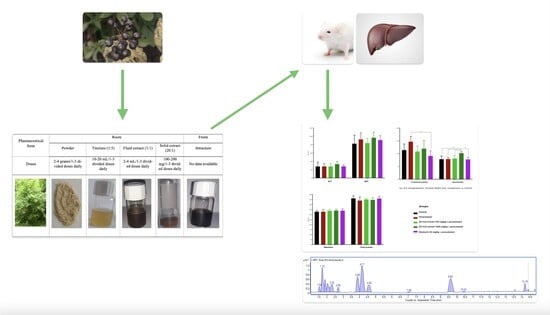
Graphical abstract
Open AccessArticle
Phytochemical Profiling, Anti-Inflammatory Action, and Human Gut Microbiota-Assisted Digestion of Rheum officinale Petiole and Root Extracts—An In Vitro Study
by
Oleksandra Liudvytska, Mariusz Kowalczyk, Justyna Krzyżanowska-Kowalczyk, Karolina Michaś, Maria Michalak, Aneta Balcerczyk, Weronika Skowrońska, Marcin Równicki, Agnieszka Bazylko, Monika A. Olszewska and Joanna Kolodziejczyk-Czepas
Nutrients 2025, 17(21), 3455; https://doi.org/10.3390/nu17213455 - 1 Nov 2025
Abstract
Background/Objectives: Rheum officinale, an ethnomedicinal plant, has roots widely employed in modern pharmacological formulations. However, many of its biological activities remain only partly recognized. Furthermore, the metabolome and biological activity of its edible petioles, often considered a waste product, have received
[...] Read more.
Background/Objectives: Rheum officinale, an ethnomedicinal plant, has roots widely employed in modern pharmacological formulations. However, many of its biological activities remain only partly recognized. Furthermore, the metabolome and biological activity of its edible petioles, often considered a waste product, have received limited scientific attention. Methods and Results: The examination of anti-inflammatory properties of both root and petiole extracts (1–50 µg/mL) revealed the inhibition of the pro-inflammatory cytokine release from human peripheral blood mononuclear cells, a reduction in ALOX5 gene expression in human umbilical vein endothelial cells, and the significant inhibition (>60%) of cyclooxygenase-2 and 5-lipoxygenase activities. Importantly, no cytotoxic effects were detected at the tested concentrations. Conclusions: The petiole extract demonstrated anti-inflammatory efficiency comparable to, or exceeding that of the root extract, suggesting that R. officinale petioles could be valuable source of bioactive compounds for future investigations.
Full article
(This article belongs to the Special Issue Food-Derived Bioactive Compounds and Their Health Benefits)
►▼
Show Figures
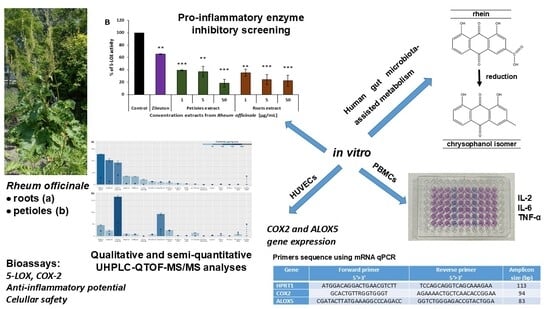
Graphical abstract
Open AccessArticle
Lactiplantibacillus plantarum, Duodenal Hydroxyphenyllactic Acid and Iron: Insights from a Rat Model of a High-Fat Iron-Deficient Diet
by
Katarzyna Skrypnik, Agnieszka Olejnik-Schmidt, Marcin Schmidt, Damla Selvan and Joanna Suliburska
Nutrients 2025, 17(21), 3454; https://doi.org/10.3390/nu17213454 - 1 Nov 2025
Abstract
Background: Lactiplantibacillus plantarum synthesizes in vitro hydroxyphenyllactic acid (HPLA)—an iron-reducing agent supposed to facilitate duodenal Fe absorption. So far, no such in vivo HPLA production has been established. This study aimed to investigate the ability of Lactiplantibacillus plantarum to produce HPLA in
[...] Read more.
Background: Lactiplantibacillus plantarum synthesizes in vitro hydroxyphenyllactic acid (HPLA)—an iron-reducing agent supposed to facilitate duodenal Fe absorption. So far, no such in vivo HPLA production has been established. This study aimed to investigate the ability of Lactiplantibacillus plantarum to produce HPLA in the duodenum in rats on a high-fat iron-deficient diet. Methods: Rats were fed a high fat (HF) diet; HF, Fe-deficient diet (HFDEF); or control (C) diet for 8 weeks. Over the next 8 weeks, animals in the C and HF groups continued on their respective diets, while animals in the HFDEF group were divided into six subgroups and received combinations of an HF, Fe-deficient diet with Lactiplantibacillus plantarum (Lp), Latilactobacillus curvatus (Lc), and Fe supplementation (HFDEF, HFDEFFe, HFDEFLp, HFDEFLc, HFDEFFeLp, and HFDEFFeLc). Duodenal and faecal samples were collected. Results: No significant differences were observed in HPLA content in the duodenum and faeces, nor in Fe chelating abilities in faeces, between study groups at the completion of the study. Fe content in faeces was higher in the HFDEFFe group than in the C, HF, HFDEF, HFDEFLp, and HFDEFLc groups. Fe content in faeces was higher in the HFDEFFeLp and HFDEFFeLc groups than in the HFDEF and HFDEFLc groups. Conclusions: Lactiplantibacillus plantarum, whether alone or with oral Fe, does not influence duodenal and faecal HPLA content, nor does it affect faecal Fe chelating abilities in rats on the HF, Fe-deficient diet.
Full article
(This article belongs to the Section Prebiotics and Probiotics)
►▼
Show Figures

Figure 1
Open AccessArticle
Perceptions of the Three Dietary Patterns of the 2020–2025 United States Dietary Guidelines Among African American Adults After a 12-Week Randomized Intervention Trial to Reduce Type 2 Diabetes Risk: A Qualitative Study
by
Halide Zeynep Aydin, Nkechi Okpara, Kelli E. Dubois, Mary M. Jones, Jessica Carswell, Sara Wilcox, Daniela B. Friedman, Angela D. Liese and Gabrielle Turner-McGrievy
Nutrients 2025, 17(21), 3453; https://doi.org/10.3390/nu17213453 - 31 Oct 2025
Abstract
Background: The United States Dietary Guidelines (USDG) form the basis of federal nutrition programs/policies for Americans. There has been little work to ensure that the presentation of the USDG are culturally acceptable and relevant for African Americans (AAs). This study aimed to explore
[...] Read more.
Background: The United States Dietary Guidelines (USDG) form the basis of federal nutrition programs/policies for Americans. There has been little work to ensure that the presentation of the USDG are culturally acceptable and relevant for African Americans (AAs). This study aimed to explore the acceptability and perceptions of a randomized intervention among AA adults adhering to unmodified dietary patterns outlined in the USDG (Healthy US, Mediterranean, Vegetarian). Methods: Qualitative focus groups were conducted with participants from a USDG-based intervention, the Dietary Guidelines: 3 Diets study (DG3D). Six focus group discussions were conducted with AA adults in the Southeastern US in December 2021, after completion of the 12-week DG3D intervention. Verbatim transcripts were coded thematically and analyzed in Nvivo12 using an iterative constant comparative method. Results: Participants (n = 42; median age 52 years, range 26–65, 16 Healthy US, 17 Mediterranean, 9 Vegetarian) shared their perspectives and experiences adopting USDG dietary patterns and reported barriers and facilitators to adopting dietary change. Discussions elicited insights into the cultural relevance of the USDG and dietary intervention. Participants also described their recommended changes to the USDG-based intervention to enhance program implementation and successful dietary change. Conclusions: Study findings suggest that adaptations to the USDG dietary patterns are needed to ensure cultural relevance for AA adults in the US. This study can inform the development of culturally relevant dietary guidelines and intervention programs.
Full article
(This article belongs to the Section Nutrition and Diabetes)
Open AccessArticle
Beneficial Effects of Long-Lasting Bicarbonate–Sulfate–Calcium–Magnesium Water Intake on Metabolic Dysfunction-Associated Steatotic Liver Disease (MASLD)-Related Outcomes via Impacting Intestinal Permeability (IP), IP-Related Systemic Inflammation, and Oxidative Stress
by
Marcello Dallio, Mario Romeo, Fiammetta Di Nardo, Giusy Senese, Alessia Silvestrin, Annachiara Coppola, Carmine Napolitano, Paolo Vaia, Claudio Basile, Giuseppina Martinelli, Alessia De Gregorio and Alessandro Federico
Nutrients 2025, 17(21), 3452; https://doi.org/10.3390/nu17213452 - 31 Oct 2025
Abstract
Background/Objectives: Fonte Essenziale®, a mineral water rich in bicarbonate, sulfate, calcium, and magnesium, has shown potential in modulating the gut–liver axis and microbiota in hepatic steatosis. However, its long-term effects on intestinal permeability (IP), systemic inflammation (SI), and oxidative stress—key
[...] Read more.
Background/Objectives: Fonte Essenziale®, a mineral water rich in bicarbonate, sulfate, calcium, and magnesium, has shown potential in modulating the gut–liver axis and microbiota in hepatic steatosis. However, its long-term effects on intestinal permeability (IP), systemic inflammation (SI), and oxidative stress—key factors in Metabolic dysfunction-associated steatotic liver disease (MASLD)—remain unexplored. Methods: Eighty-seven MASLD patients were randomized into two groups: group A received Fonte Essenziale® (400 mL/day, fasting) plus a controlled nutritional regimen for 12 months, followed by a 6-month water washout; group B followed only the controlled nutritional regimen. IP markers, SI (IL-1β, IL-6, TNF-α), oxidative stress (dROMs/BAP), and clinical data (including Controlled Attenuation Parameter—CAP) were assessed at baseline (T0), 12 months (T12), and post-washout (T18). Baseline increased IP (in-IP) was defined by fecal zonulin > 110 ng/mL and serum LBPp > 10 µg/mL; improvement (im-IP) required normalization of both. A ≥30% CAP reduction indicated steatosis improvement. Results: Thirty-eight patients in group A and thirty-nine in group B completed the study. At T12, group A showed significant reductions in fecal zonulin (p: 0.0163) and serum LBPp (p < 0.0001), with increased occludin and claudin 1 (all p < 0.0001). Im-IP prevalence was higher in group A (p: 0.0037). Group A also showed significant reductions in IL-1β, TNF-α, IL-6, LPS, and dROM/BAP (all p < 0.05), especially among those with im-IP. CAP, insulin, and HDL levels improved significantly (all p < 0.0001). Multivariate analysis confirmed water intake (aOR: 2.185, p: 0.001) and im-IP achievement (aHR: 1.267, p: 0.021) as predictors of steatosis improvement. Benefits persisted at T18. Conclusions: Prolonged Fonte Essenziale® intake improved hepatic steatosis and MASLD outcomes by modulating IP, SI, and oxidative stress. This trial has been registered on clinicaltrials.gov (NCT07211113).
Full article
(This article belongs to the Special Issue The Interplay Between Nutrients and the Intestinal Barrier in Metabolic Liver Diseases: From Bench to Bedside)
►▼
Show Figures

Figure 1
Open AccessReview
The Multi-Dimensional Action Map of Resveratrol Against Alzheimer’s Disease: Mechanism Integration and Treatment Strategy Optimization
by
Yichen Liu, Yadan Dong, Zhen Cao, Yixuan Ji, Xiaoxin Cheng and Xu Zheng
Nutrients 2025, 17(21), 3451; https://doi.org/10.3390/nu17213451 - 31 Oct 2025
Abstract
Alzheimer’s disease (AD) represents a prevalent neurodegenerative disorder marked by a gradual decline in cognitive and behavioral functions. Despite advancements in elucidating several potential mechanisms underlying the pathogenesis of AD, there remains a limitation in effective supplements or medications for its intervention. Resveratrol,
[...] Read more.
Alzheimer’s disease (AD) represents a prevalent neurodegenerative disorder marked by a gradual decline in cognitive and behavioral functions. Despite advancements in elucidating several potential mechanisms underlying the pathogenesis of AD, there remains a limitation in effective supplements or medications for its intervention. Resveratrol, a natural antioxidant, has emerged as a significant player in the treatment of AD. This article reviews the role of resveratrol in four key aspects: amyloid plaque deposition and neurofibrillary tangles, inflammatory response and oxidative stress, energy metabolism and mitochondrial homeostasis, and neuroprotection and regeneration. Furthermore, we also explore treatment strategies to enhance the therapeutic effect of resveratrol.
Full article
(This article belongs to the Special Issue Antioxidants in Diet: Metabolic Impacts and Mechanisms of Action)
►▼
Show Figures
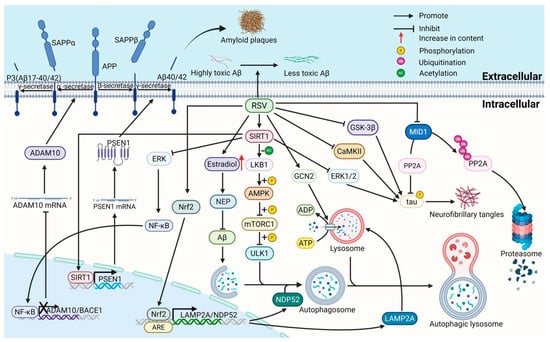
Figure 1

Journal Menu
► ▼ Journal Menu-
- Nutrients Home
- Aims & Scope
- Editorial Board
- Reviewer Board
- Topical Advisory Panel
- Instructions for Authors
- Special Issues
- Topics
- Sections & Collections
- Article Processing Charge
- Indexing & Archiving
- Editor’s Choice Articles
- Most Cited & Viewed
- Journal Statistics
- Journal History
- Journal Awards
- Society Collaborations
- Conferences
- Editorial Office
Journal Browser
► ▼ Journal BrowserHighly Accessed Articles
Latest Books
E-Mail Alert
News
Topics
Topic in
Biomolecules, Cancers, IJMS, Nutrients, Antioxidants
Advances in Adiponectin
Topic Editors: Puran S. Bora, Mayank ChoubeyDeadline: 24 November 2025
Topic in
Cancers, Children, Nutrients
Nutrition and Health During and After Childhood Cancer
Topic Editors: Valérie Marcil, Joya ChandraDeadline: 15 December 2025
Topic in
Applied Microbiology, Fermentation, Foods, Microbiology Research, Microorganisms, Nutrients
News and Updates on Probiotics
Topic Editors: Alessandra Pino, Mutamed AyyashDeadline: 31 December 2025
Topic in
Behavioral Sciences, IJERPH, Nutrients
Lifestyle Medicine and Nursing Research
Topic Editors: Yibo Wu, Zheng Guo, Zheng Feei Ma, Feng JiangDeadline: 30 January 2026

Conferences
Special Issues
Special Issue in
Nutrients
Sustainable and Resilient Food Systems
Guest Editors: Mēgan M. Patton-López, Emily H. Belarmino, Zubaida QamarDeadline: 5 November 2025
Special Issue in
Nutrients
Nutrition, Lifestyle and Health Outcomes in Older Adults
Guest Editor: Ruoling ChenDeadline: 5 November 2025
Special Issue in
Nutrients
Herbal Extracts and Phytochemicals: Nutrition, Bioactivity, and Safety Assessment
Guest Editor: Barbara Bobrowska-KorczakDeadline: 5 November 2025
Special Issue in
Nutrients
Lifestyle Factors, Nutrition and Mental Health in Adolescents
Guest Editor: Ming LiDeadline: 5 November 2025
Topical Collections
Topical Collection in
Nutrients
Connection between Microbiome, Lifestyle and Diet
Collection Editors: Eva Untersmayr, Peter M. Abuja
Topical Collection in
Nutrients
Nutritional Epidemiology among Chinese Populations
Collection Editors: Liang Wang, Gangqiang Ding, Xinyin Jiang
Topical Collection in
Nutrients
Bioactive Peptides: Challenges and Opportunities
Collection Editor: Carmen Lammi
Topical Collection in
Nutrients
Advances in Phenylketonuria (PKU) Nutrition and Diet Research (2nd Edition)
Collection Editors: Júlio César Rocha, Anita MacDonaldConference Reports
Nutrients 2024, 16(15), 2528; https://doi.org/10.3390/nu16152528
Nutrients 2024, 16(8), 1157; https://doi.org/10.3390/nu16081157







